One day after the Government issued Decree 232/2025/ND-CP (Decree 232) amending and supplementing Decree 24/2012/ND-CP on the management of gold trading activities, the domestic gold market recorded a price that was still quite different from the world price.
Gold prices continue to rise
At the end of August 27, major gold businesses listed the price of SJC gold bars at 126 million VND/tael for buying and 128 million VND/tael for selling, an increase of 300,000 VND/tael compared to the previous session.
This continues to be the historical peak of SJC gold bars. Meanwhile, 99.99% gold rings and jewelry gold are not out of the trend, fluctuating around 119.9 million VND/tael for buying and 122.4 million VND/tael for selling, 200,000 VND higher than the previous day.
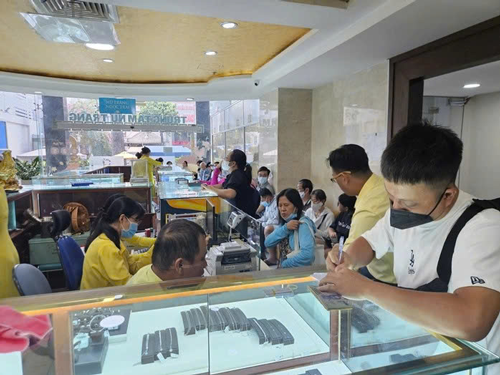
Many people still lined up to buy gold rings and gold bars at SJC Company on August 27. Photo: THAI PHUONG
However, the reality recorded at the headquarters of Saigon Jewelry Company (SJC) in Ho Chi Minh City shows that the purchasing power of gold bars is still very high. On the morning of August 27, many people lined up to buy but each customer was only allowed to buy a maximum of 1 tael of gold bar because the quantity sold was limited.
At around 10 o'clock, the company announced that they ran out of gold bars, so some people had to quietly leave. Others switched to buying plain gold rings, but each person could only buy 1 tael of gold ring by bank transfer and 1 tael in cash.
By the afternoon, both gold bars and gold rings were scarce, and employees had to announce a temporary suspension of sales pending additional supply. "After the news of Decree 232, some customers brought gold to sell because they were worried that the price might drop, but the number of buyers was still overwhelming. This made it difficult for the price to drop as deeply as expected, and even increase following the world trend. If more gold was sold, the company would have gold to meet the demand, but now there is almost none left," an employee here shared.
Mr. Nguyen Ngoc Trong, Director of New Partner Gold Company (NPJ), said that the main reason for the above scarcity is not necessarily due to too much demand but because the market lacks supply. "The price of SJC gold bars is currently 20 million VND/tael higher than the world price, equivalent to a difference of 18.5%, an unprecedented record. Meanwhile, the Government 's management goal is to narrow this gap to 1%-2%.
If there is timely intervention, the price will cool down sharply. In the past, there were days when the market dropped by up to 5 million VND/tael when the management agency intervened. But now, the market is still waiting for a specific move, while businesses do not have gold to sell, leading to the price being pushed up" - Mr. Trong commented.
Enter the "new game"
However, domestic gold traders still hope that the new management mechanism will create healthy competition, helping domestic gold prices get closer to the world.
"When many units join the supply chain, the source of goods will be more abundant, the domestic gold price will be closer to the world price. There will no longer be gaps that cause insecurity for people and disorder for the market, because one unit holding the entire supply chain can easily create distortions, whether intentionally or unintentionally" - the director of a gold company in Ho Chi Minh City expressed.
This person believes that when the supply is diversified, the market will reflect the actual supply and demand more closely, limiting the situation where prices are influenced by psychological factors or rumors. The new decree also shows that the State is gradually creating an equal business environment, something that private enterprises have long expected. More importantly, when the domestic gold price narrows compared to the world price, the source of gold in the people, a huge asset that is "sleeping", can be unlocked, creating more momentum for the economy .
Mr. Nguyen Duc Anh, Business Development Director of Bao Tin Manh Hai Jewelry Joint Stock Company, assessed that the current abandonment of the gold bar monopoly is "ripe", because the market has been suffering from scarcity for too long. "The most important thing is to create a supply source, thereby helping stabilize the gold price and approach the world gold price, solving the major problem in the market in the past few years. We expect the gold price to approach the world price" - Mr. Duc Anh shared.
However, he also admitted that not every business can "jump" into the market immediately, because to be licensed, in addition to capital, units also need infrastructure, technology, quality control processes and especially brand reputation.
Mr. Anh said that Bao Tin Manh Hai itself will also have a roadmap to increase capital to qualify for participating in gold bar production. Because, investing in infrastructure and expanding the gold bar distribution system to many locations is a mandatory requirement, it cannot rely only on available resources. That means, although the new decree opens up opportunities, the "ticket" to enter the game is still not easy.
Waiting for new supply
However, the question is when will the market have SJC gold bars from new imported raw gold sources? According to a representative of a gold company, this depends on the licensing speed of the State Bank (SBV). For businesses that already have production workshops and processing experience, the process can be quick.
But for commercial banks that have never participated in gold bar production, investing in building factories, technology and management processes will take a lot of time. "Depending on the strategy of each unit, they will consider whether to participate or not and on what scale," he said.
Mr. Huynh Trung Khanh, senior advisor of the World Gold Council in Vietnam, recommended that the management agency should soon issue criteria and quotas for gold imports for each unit to quickly bring new supply to the market. According to him, enterprises and banks will have to report the expected demand for raw gold within 1 year, from which the State Bank will synthesize and calculate the total amount of gold to be imported.
"This process cannot happen overnight, so the price of SJC gold bars cannot decrease as expected. For example, in 2024, in about 7 months, the State Bank supplied 354,100 taels of gold bars, equivalent to 13 tons of gold to the market, but this number still does not fully reflect the real demand of the people," said Mr. Khanh.
Statistics from the Vietnam Gold Trade Association (VGTA) show that the demand for raw gold to produce gold bars and jewelry averages about 50 tons/year, equivalent to 5 billion USD. Of which, about half is used to meet domestic demand, the rest is for export. Gold jewelry exports alone can bring in 3.5 - 4 billion USD/year.
This means that if the import mechanism is implemented smoothly, Vietnam will not only have more gold supply for the domestic market but also take advantage of export opportunities to earn foreign currency.
Regarding concerns that the amount of foreign currency used to import gold will put pressure on the currency market, VGTA said that the figure of 5 billion USD/year is insignificant. On average, each month, businesses need about 416 million USD to import gold, while transactions on the interbank foreign currency market reach 900 million to 1.2 billion USD per day, or 18.9 - 25.2 billion USD per month.
Therefore, the need for gold imports is completely within the capacity of the banking system, does not affect the supply and demand of foreign currency, and does not force the State to use foreign exchange reserves to intervene.
Avoid risks, ensure sustainability
According to Decree 232/2025/ND-CP, the State Bank will license commercial banks and qualified enterprises to produce gold bars, and allow the import of raw gold for production. The conditions are not easy: enterprises must have a charter capital of VND 1,000 billion or more, while commercial banks must reach VND 50,000 billion.
With such high requirements, the number of units that can participate in the market initially is not much, mainly large banks such as Vietcombank, VietinBank, VPBank, Techcombank, BIDV, MB, and "leading" enterprises such as SJC, PNJ, DOJI. The State Bank explained that the "huge" charter capital criteria is to ensure that only organizations with sufficient financial capacity, management experience and reputation are allowed to produce gold bars, avoiding risks and ensuring the sustainability of the market. This is also the way the State plays a supervisory and management role, while still expanding the space for private enterprises to participate.
Opening up export opportunities
Mr. Le Chanh, owner of a private gold trading company at Ba Chieu market (HCMC), said that the regulation requiring units when buying and selling raw gold to use electronic invoices, store data and connect information with the State Bank is a necessary step to make transactions transparent. Because this not only limits the risk of using gold for illegal activities but also opens up opportunities for gold export in the future. "With a stable source of raw materials and if the market is favorable, businesses can export gold, earn USD, and compensate for the foreign currency spent on gold imports," Mr. Chanh analyzed.
According to Mr. Chanh, although small gold businesses cannot directly import raw gold, they still benefit from the new mechanism because they can access quality gold from large units at reasonable prices. "From there, gold shops can focus on designing and processing products to better compete with big brands," he said.
Source: https://nld.com.vn/de-thi-truong-vang-som-ha-nhiet-196250827212655612.htm



![[Photo] National Assembly Chairman Tran Thanh Man attends the VinFuture 2025 Award Ceremony](/_next/image?url=https%3A%2F%2Fvphoto.vietnam.vn%2Fthumb%2F1200x675%2Fvietnam%2Fresource%2FIMAGE%2F2025%2F12%2F05%2F1764951162416_2628509768338816493-6995-jpg.webp&w=3840&q=75)
![[Photo] 60th Anniversary of the Founding of the Vietnam Association of Photographic Artists](/_next/image?url=https%3A%2F%2Fvphoto.vietnam.vn%2Fthumb%2F1200x675%2Fvietnam%2Fresource%2FIMAGE%2F2025%2F12%2F05%2F1764935864512_a1-bnd-0841-9740-jpg.webp&w=3840&q=75)










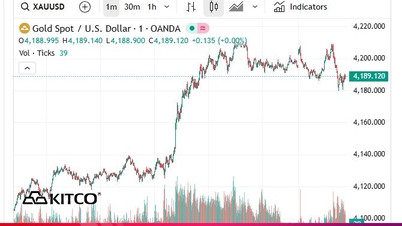

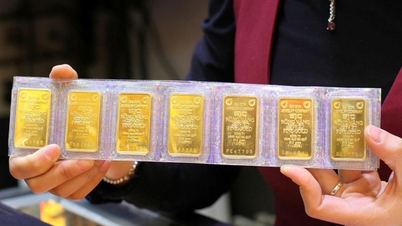


























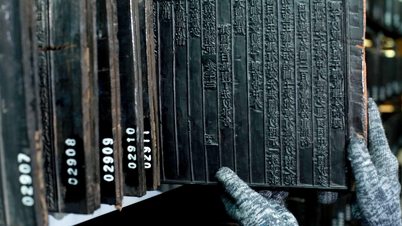































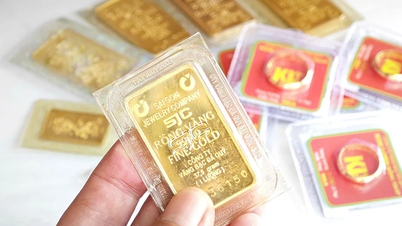































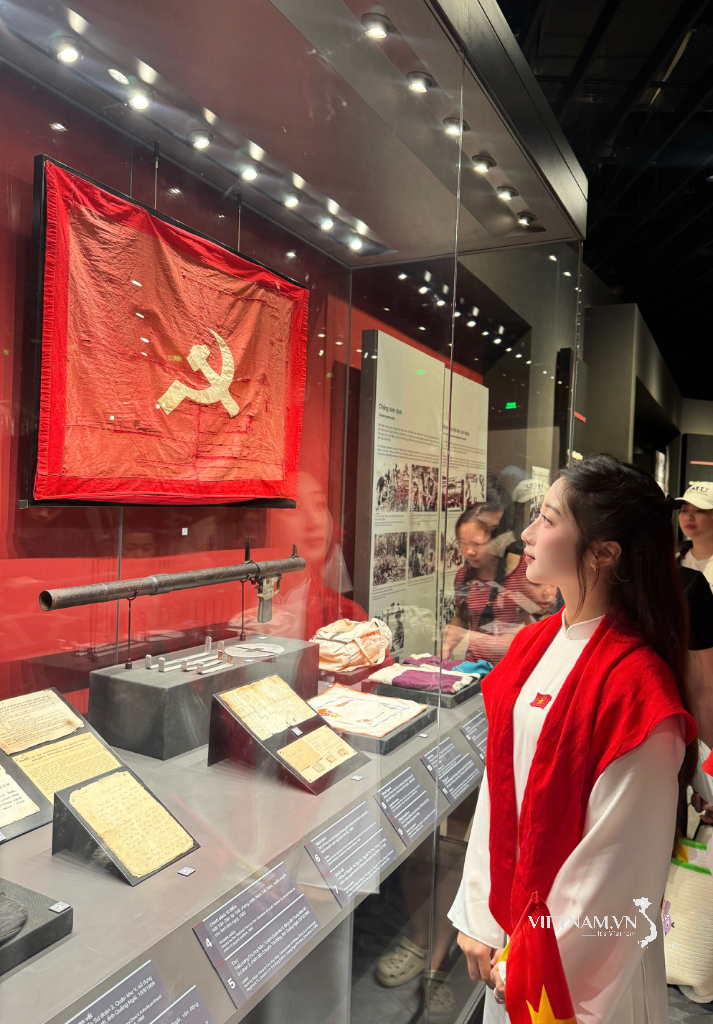





Comment (0)